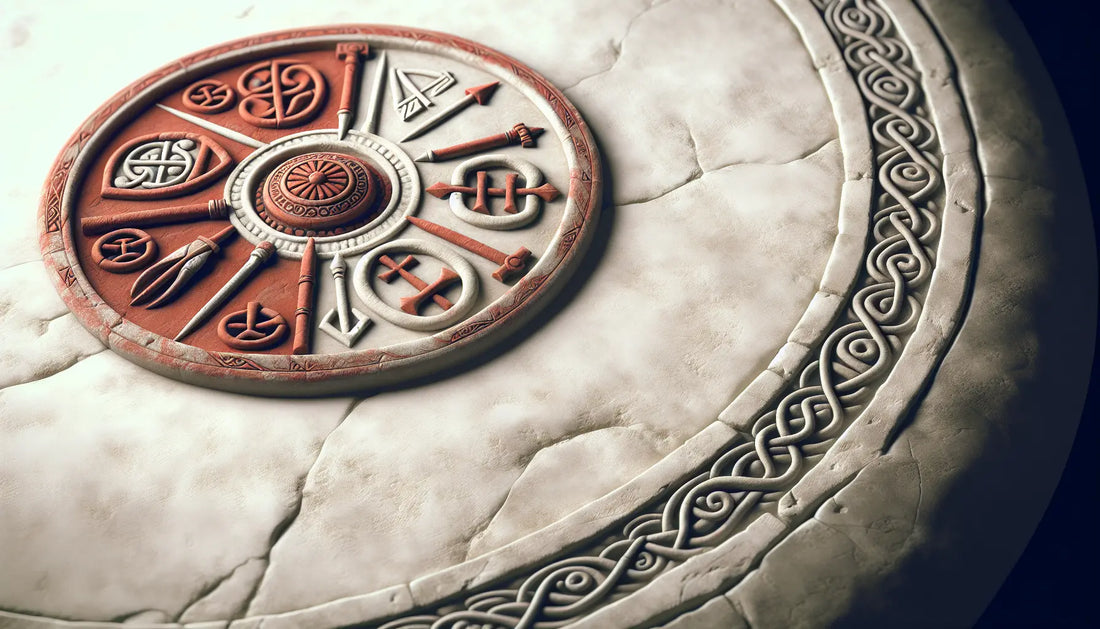
Is Lagertha a Real Viking? Unraveling the Legend
Interesting facts
Is Lagertha a Real Viking? Exploring the Legend and Historical Reality
When we hear the name Lagertha, vivid images burst to life: fierce battle cries echoing across icy fjords, longships cutting through misty waters, and a woman standing fearless, sword in hand, amid the clash of swords and shields. Lagertha shines in popular imagination as the very embodiment of the Viking shieldmaiden — a warrior woman carving her place in a world ruled by men. Yet, as captivating as her story feels, how much of it rests on real history, and how much on legend and myth? Is Lagertha a true Viking or a powerful symbol born from the vibrant tales of Norse culture?
The Legendary Saga of Lagertha
Our knowledge of Lagertha primarily comes from the Gesta Danorum (Acts of the Danes), written in the 12th century by the Danish historian Saxo Grammaticus. In this evocative saga, Lagertha emerges as a courageous and formidable shieldmaiden fighting alongside Ragnar Lothbrok, a towering figure in Norse legend known for his exploits and daring raids.
She is described not as a mere side character but as a fierce warrior who dressed in armor typically worn by men, leading troops into battle, and defending her homeland with unmatched valor. Her story brims with dramatic moments—swinging axes, fierce combat, and moments of strategy and leadership that hint at a woman who commanded respect through her courage and deeds, rather than just her role as Ragnar’s wife.
But legends are often the weaving of extraordinary threads, blending heroism, cultural ideals, and storytelling flair. Beyond these exciting narratives, we must ask: what historical truths underpin Lagertha’s tale?
Historical Existence: Fact and Fiction Intertwined
The question of Lagertha’s real existence is complicated by the nature of her sources. The Norse sagas, including Gesta Danorum and Icelandic tales, are a blend of history, myth, and oral tradition, recorded centuries after the events they recall. They carry echoes of actual events but are woven through with poetic or dramatic enhancements, making it tricky for historians to separate fact from fiction.
Unlike Viking chieftains whose names appear in runestones, foreign chronicles, or multiple contemporary accounts, Lagertha appears mainly in legendary texts without corroborating evidence from archaeology or documents of her time. This lack of independent confirmation suggests she might represent an idealized image or a folklore composite rather than a clearly identifiable historical figure.
However, it is also possible that Lagertha was based on a real woman whose story grew in stature through retellings—transformed over time into a symbol of female might and resilience. Interestingly, the influence of Lagertha’s legend stretches even into modern times. For example, some contemporary products, like a fitness tracker named “Lagertha,” draw on her spirit of endurance and resilience, weaving ancient narratives into today’s stories of strength and perseverance.
Shieldmaidens: Were They Real?
The idea of shieldmaidens, women donning armor and fighting on the front lines, fascinates both historians and enthusiasts alike. Viking culture was undoubtedly patriarchal, with men commonly taking roles as warriors and raiders, yet women managed households, farms, and sometimes wielded influence behind the scenes. Could they have also taken up arms?
Recent archaeological findings provide tantalizing clues. Graves of women buried with weapons and items typical for warriors have been discovered, such as the remarkable burial at Birka, Sweden, where a female skeleton was found alongside swords, shields, and horses—all hallmarks of a warrior’s resting place.
This discovery challenges old assumptions and suggests that some women may indeed have fought or served as warriors in Viking society. Yet, scholarly debate continues. Some argue that weapons found in female graves might symbolize status or familial connections rather than direct evidence of combat roles. Literary sources rarely portray women as combatants, and when they do, these accounts might be symbolic or exceptional.
So, while there is growing acceptance that Viking women sometimes bore arms, it is less clear how widespread this practice was or whether Lagertha stands as an example of an extraordinary individual or a generalized archetype.
The Cultural Role of Warrior Women in Norse Legends
Beyond historical debates, the Norse mythological tapestry is rich with strong female figures. Valkyries, mystical warrior women who decide the fate of fallen warriors, queens who govern and strategize, and shieldmaidens who break gender boundaries all populate these stories.
Lagertha fits seamlessly within this tradition. Whether flesh-and-blood or not, she symbolizes a powerful narrative about women's strength and agency. She challenges the notion of Viking women as solely domestic caretakers, revealing a culture more complex than simple stereotypes suggest.
For Vikings, tales about women warriors might have served multiple purposes: inspiring courage, embodying cultural ideals, or warning against crossing societal boundaries. Today, these stories open a window onto more nuanced pasts and encourage us to rethink rigid gender roles of long ago.
Bridging Mythology and History
The struggle to untangle history from legend in Lagertha’s story exemplifies a broader puzzle for historians of ancient narratives. Oral traditions carry cultural memory but often mix fact, symbolism, and artistic license. Written records that arrive centuries later reflect this layered storytelling.
Analyzing Lagertha demands a careful reading between the lines—balancing archaeological proofs with textual evidence and recognizing her as both a potential historical figure and a mythic archetype. She may well embody the collective ideals of Viking womanhood: fierce, capable, and resilient.
The fascination with Lagertha speaks to a universal human yearning for heroes that defy expectation—not just warriors named in history books but figures who symbolize courage and challenge boundaries.
What Does This Mean for Our Understanding of Vikings?
Lagertha’s story invites us to revisit popular images of Viking society, shattering the one-dimensional portrayal of Vikings as rough, raiding men. Women, though constrained by societal norms, held more influence and complexity than typically recognized.
Do myths about Viking women have contemporary relevance?
Yes, myths about Viking women like Lagertha continue to resonate today as they challenge gender roles and inspire contemporary movements emphasizing women's empowerment and equality. These stories provide cultural narratives that encourage modern audiences to re-evaluate traditional gender norms and celebrate strength, leadership, and resilience across genders.
Historical artifacts and sagas suggest Viking women could possess property, wield political power, and on some occasions, take up arms. Whether through real experience or inspiration, the idea of women like Lagertha expands our understanding of this dynamic society.
Moreover, the debate about figures like Lagertha reminds historians to remain humble about evidentiary limits. Our modern categories—“warrior,” “gender role”—may not easily map onto Viking realities, highlighting the fluidity and richness of the past.
Personal Reflections on Lagertha’s Appeal
Encountering Lagertha’s tale feels like stepping through an enchanted door—suddenly, the strict dichotomies of gender and power blur. She has an almost magnetic presence: a woman who stands undeterred on battlefields, matching the fiercest men, thriving in a brutal world where survival required unyielding strength.
Stories like hers resonate deeply because they voice a timeless wish: to be judged not by prescribed roles but by one’s abilities and spirit. Could she have really lived? Perhaps. But even if her story looms large as legend rather than fact, it carries truth about human aspiration and the complexity of identity.
Lagertha reminds us history is more than dates or names—it is the narratives we build and the values we hold dear.
Consider adding a piece of history to your modern wardrobe. The Roman Gladius Necklace is perfect for those inspired by historical legends. Discover this unique piece here.
Conclusion: Lagertha, Between History and Legend
In the end, Lagertha’s place in Viking history hovers in the space between myth and possible reality. The sagas gift us dramatic portraits of a shieldmaiden wielding axe and shield with unmatched bravery, yet the concrete historical record offers no direct confirmation of her life.
Archaeology suggests that Viking women might have joined battles in some capacity, though these findings are complex and open to interpretation. Thus, Lagertha may best be seen as a potent symbol of female strength in Viking culture—representing both the norm and the exception, the known and the imagined.
This balanced perspective lets us appreciate Lagertha not only as a legendary figure in Norse lore but also as a lens through which we glimpse the social and cultural world of the Vikings—a world where myth and history blend, and where the stories we inherit shape our view of history.
Whether Lagertha was an actual Viking shieldmaiden or a mythic ideal, her story endures — inviting us to reflect on how history and legend intertwine, shaping both our understanding of the past and how we see ourselves. Perhaps that, above all, is why Lagertha’s legend still captivates hearts and imaginations today.
Learn more about the Viking era and its cultural impact in shaping societies across the world.
*By opening the door to considering both myth and history, Lagertha’s story enriches how we think about the Viking Age and the women who lived through it—reminding us that courage and strength can take many shapes and that the past holds more surprises than we often imagine.*
Who was Lagertha in Viking legends?
Lagertha is depicted as a legendary Viking shieldmaiden who fought alongside Ragnar Lothbrok and symbolized female strength and agency in Norse mythology.
Is there historical evidence of Lagertha's existence?
Most evidence of Lagertha comes from Norse sagas like the Gesta Danorum which blend history and myth, without concrete archaeological confirmation of her existence.
What modern-day product captures the spirit of Lagertha?
The Roman Gladius Necklace is a product that embodies the strength and resilience associated with Lagertha's legendary spirit.

